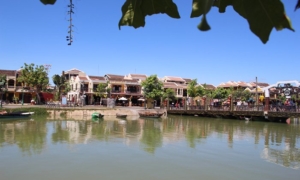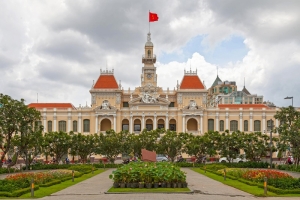The Hanoi Opera House, overlooking Trang Tien Street, is one of the busiest and most crowded areas of Hanoi City.
Hanoi Opera House, a unique theatre in Vietnam near the Old Quarter, was built by the French people in 1901 and completed in 1911 in a French neoclassical style. It is also considered a copy of the Garnier Opera House in Paris. Nowadays, the Opera House in Hanoi is a symbol of culture, history, and architecture.
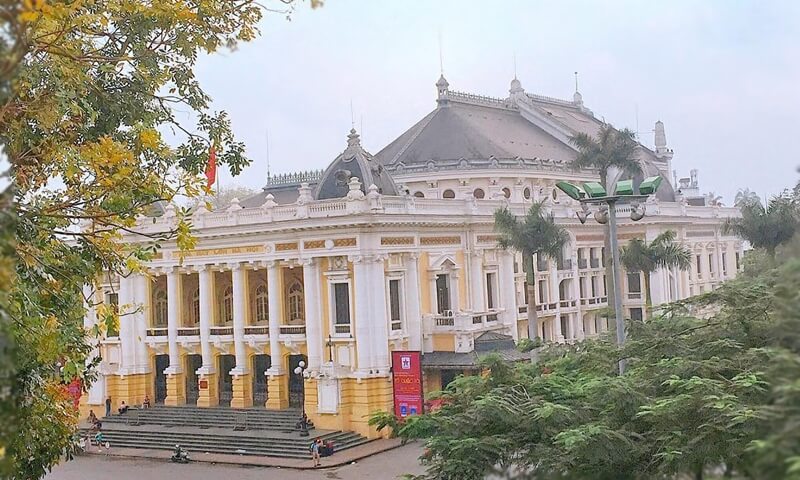
The theatre is 87 m long and has an average width of 30 m. Its highest rooftop is 34 m above the road, and its construction area is about 2,600 m2.
The architecture of the Hanoi Opera House
The Opera House in Hanoi is modeled under the influence of the Paris Opera House but smaller, and the materials are changed according to local economic and climatic conditions.
For the overall architecture outside Hanoi Opera House:
The main façade of the Opera House stands out. Roman Ionic columns form five hollow spaces in the middle and two solid chambers at the gable and above. A curved roof with stone tiles further decorates the façade. Renaissance architectural principles seem to be emphasized here.
However, when approaching the building, the Baroque elements stand out, with the winding curves of the balconies combined with the arched form above the entrance, especially the sophisticated decorations, which were created by a combination of architects and sculptors.
The Baroque elements are almost overwhelming. The columns only repeat outside the hall instead of rectangular windows or arches. The walls are filled with decorative motifs and winding support rods; all are rich in sculpture.
The top of the theater, with its black stone tiles, gives us a sense of the French neoclassical spirit. The roof is organized very carefully, combining many forms:
- The pyramid-shaped roof at the connections
- Curving roofs in the auditorium area
- The triangular roof above the stage
The attractive sculpting elements emphasize the surroundings and the top of the roofs.
For the internal architecture of the opera house:
The layout of the Hanoi Opera House is designed like horseshoes for the large room, the entrance to the hall, and the main staircase. The organization of the stage of the Hanoi Opera House is the same as that in Europe at the beginning of the 20th century.
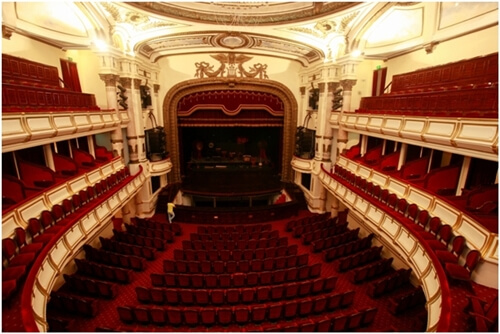
The internal theatre is organized into three parts:
1. Main lobby
This room is the first place to welcome guests to the theater. A stone T-shaped staircase leading to the second floor is paved with high-quality stone imported from Italy; the stairs, with colors matching the space and scale of the lobby, create a feeling like a big rug.
The small chandeliers hanging on the wall are plated with antique copper, and the overhead chandeliers are plated with a layer of gold, according to new technology.
2. Mirror Room
The mirror room (located on the 2nd floor, including the main room and 2 small rooms on two sides) is essential for regularly welcoming high-ranking officials and heads of other countries and for the ceremony to sign important government documents.
Also, the mirror room is a venue for performing chamber music shows, press conferences, and conducting small conferences.
The mosaic technique completely restores the mirror Room floor. Mirror floor bricks are taken from Italy, and skilled Italian craftsmen guided workers to set them up by hand to ensure the sophistication of the project.
On the walls, each large mirror hangs between two doors. The hanging lamps, crystal chandeliers, tables, and chairs have a French classic style.
3. Audience room
Inside the theater is a large stage and a 24x24m wide audience room, with 586 seats on all three floors. The audience room floor is covered with high-quality bricks and fireproof carpets. The chairs are designed in the classic French style of the nineteenth century.
This room was ornately decorated with Corinthian columns supporting a ceiling painted with colorful frescoes, plaster embossed paintings, and a sizeable gold-plated crystal chandelier. French painters painted these paintings.
Finally, behind the stage are 18 dressing rooms for actors, two gyms, working rooms, a library, and a meeting room.
Many of you wonder, “Why did the French construct this opera house?” Keep looking below to know the reasons.
Reasons the French built an Opera House in Hanoi
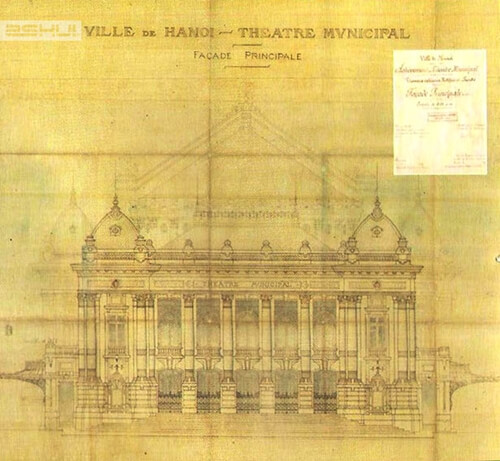
The main face was designed by architect F.Lagisquet in 1909 – Photo: ashui.com
In the late nineteenth and early twentieth centuries, many French emigrated to colonial countries, including Vietnam. In Hanoi, many French people retired but did not return who had joined the French army and the government apparatus used to work in this city. These people formed their communities, which began to have many cultural and artistic activities.
They devised many games and entertainment. Amateur music players gathered into bands, and drama lovers set up teams to perform together. At this time, Hanoi and Hai Phong (the city closest to Hanoi) did not have a theater. Therefore, the French community desperately needed a theater because expatriates wanted spaces for their artistic activities.
One day, in the middle of the summer of 1901, the Hanoi Opera House started leveling the swamp of two villages in Phuc Lam and Tho Xuong District (former names of Trang Tien and Hoan Kiem districts in Hanoi, Vietnam).
According to historical documents, 300 workers worked every day. They used concrete blocks to press 35,000 bamboo piles nearly a meter long to reinforce the theater’s foundation. About 600 tons of iron and steel and 12,000 m3 of materials were used for construction, which lasted for a decade and was completed in 1911. The Opera House Hanoi was a luxury building with stairs stretching ahead, the doors overlooking the Theater Square (today called the Square of August Revolution).
In the past, this Opera House was a place to perform classical art: opera, chamber music, and drama. The audience came mainly from the upper-class French and rich Vietnamese people.
Then, this work was associated with many historical events of the August Revolution and the early years of Vietnam, such as the meeting of the Viet Minh (August 17, 1945), the Liberation Army of Viet Bac’s return to Hanoi (August 29, 1945), the first day President Ho Chi Minh came to the Hanoi Opera House (September 2, 1946), and the National Assembly’s meeting to sign the 1946 Constitution.
How can you visit the Hanoi Opera House nowadays? Please continue reading below to learn more details so you can easily see it.
Guide to visiting Hanoi Opera House
The opera house is one of the famous attractions in Hanoi. It is also a venue for professional music programs for the people of Hanoi, senior officials of other countries, and tourists.
Open to tourists every Monday and Friday, Hanoi Opera House has welcomed many visitors to visit the house and enjoy the art.
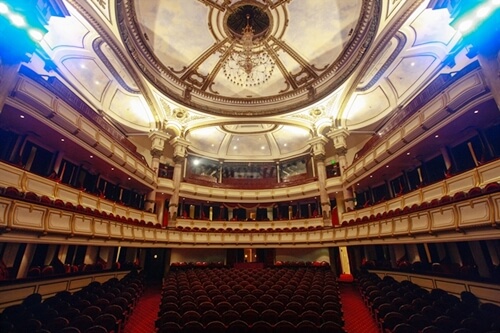
Coming to the Opera House of Hanoi, you will have about 90 minutes to learn the history of the building, and you can explore the display area of artifacts associated with its development. With this experience, travelers can see the luxurious space of the theatre, which is like the paradise of art.
At the entrance is the main hall with a stone T-shaped staircase leading to the 2nd floor, the marble on the floor, a small wall-mounted chandelier system with antique bronze plating, and crystal chandeliers plated a sophisticated layer of gold. The staircase of the Hanoi Opera House has remained the same since its construction in 1911.
The Chamber of Secretariat, also called the Mirror Room, is on the second floor. It is the venue for important ceremonies, the signing of government documents, and the reception of high-ranking figures.
Travelers can see traces of bullet marks in the battle of Hanoi in 1946 that were still intact. This was the opening battle for the First Indochina War between Viet Minh and French expeditionary forces (December 19, 1946 – February 18, 1947).
The balcony in front of the Opera House is a gallery of photos of the events in August Revolution Square. Visitors can see August Revolution Square from here.
You can also visit the auditorium area, where cultural activities and performances from Vietnam and other countries are shown. The theater’s auditorium is 24×24 m and has a large stage, three floors of seats, and 586 seats in total.
While visiting the Opera House, guests can enjoy art performances and folk shows in the auditorium.
• Address: 1 Trang Tien Street, Hoan Kiem Street, Hanoi, Vietnam
• Ticket Price: VND 400,000 / pax (50% discount for students)
• Opening time for visiting: 10:30 AM every Monday and Friday.
• Duration of exploration: 1 hour and 30 minutes (from 10:30 AM to 12:00 PM)
• Visitors can buy tickets directly at the Opera House at 01 Trang Tien Street or contact to book tickets at (024) 3 933 0131, (024) 3 933 0113/224, and hotline 0961669988.
• The Opera House of Hanoi also has different shows on the other days with tickets from 200,000VND. See the schedule of performance.
